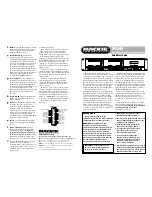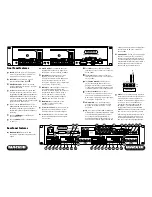
Safety First!
Before connecting and using the
equipment, please read this Quick-Start Guide
carefully and keep it for future reference.
WARNING!
This equipment has been
designed to be installed by qualified
professionals only! There are many factors to
be considered when installing professional
sound reinforcement systems, including
mechanical and electrical considerations, as
well as acoustic coverage and performance.
Mackie Industrial strongly recommends that
this equipment be installed only by a
professional sound installer or contractor.
Part No. 0000116 Rev. A 8/01
© 2001 Mackie Industrial. All Rights Reserved. Printed in the USA.
CAUTION:
To avoid the risk of electric
shock, never allow this equipment to
be exposed to rain or dampness.
SP2400
Dual-Channel Program Controller/Amplifier
Quick-Start Guide
The SP2400 is a microprocessor-based
dual-channel music controller with two built-in
power amplifiers designed for use in a variety
of installations such as retail stores, restaurants,
bars, and theme venues. It provides two outputs
that can be used for either stereo operation or
two-zone coverage. Four stereo line-level inputs
are provided on the rear panel, along with a
paging mic input and two local mic/line inputs.
The program input sources can be
independently assigned to each zone with the
Input Select switches on the front panel. Each
of the four inputs can be operated in either
stereo or mono mode, and has an integral AGC
circuit to automatically compensate for level
differences between the input sources. Input 1
has a buffered line-level output that may be
used for music-on-hold or other external
applications. Program Priority can be assigned
to Input 4 for use with a jukebox or alternative
paging configurations.
Each mic/line input has a 40 dB gain switch,
variable gain trim, phantom power switch, and
a two-band EQ. In addition, each zone has a
variable VOX control for adjusting the trigger
threshold of the paging mic's ducking circuit.
The paging mic operates in both zones when
voice-activated, but can be assigned to operate
in either Zone A or Zone B, or in both Zones when
manually operated with a switch connected to
the PAGING MIC CONTROL connector.
Each zone is equipped with an input for an
optional ambient microphone that can sample
the ambient noise level in the room and
adjust the paging mic gain in each zone to
compensate for increased or decreased noise
levels.
Internal jumpers are provided for configur-
ing the amplifier outputs for 70V, 100V, or 8-
ohm operation.
The SP2400 ships configured
for 70V operation (U.S. versions).
(continued on last page)
REMOTE
is a 3-pin Phoenix-type connector
for the optional wired remote control
(SP-41R), which provides Input Select
and Master Volume control.
EXPANSION IN/OUT
consists of two
parallel 25-pin D-Sub connectors for
connecting multiple SP2400s together in a
serial fashion. Any of the four program
sources from any SP2400 can be used as
the source for any of the zones in the
system by assigning it to the expansion
bus with the internal Bus Assign switches.
This is a balanced bus for the four stereo
input sources. In addition, the paging mic
and paging control signal are also
provided on the EXPANSION bus.
LOCAL/REMOTE
is a set of eight DIP
switches used to select the input source
for the channel between the local program
input and the remote EXPANSION IN bus.
Each program input has two switches, one
to select the left signal source (odd-
numbered switches) and one to select the
right signal source (even-numbered
switches).
STEREO/MONO
switches configure each
input source for either stereo or mono
(zone) operation.
PRE OUT
is an unbalanced RCA jack that
provides a line-level signal from the
preamplifier stage of the SP2400. This
provides a method for inserting an
external signal processor into the signal
chain prior to the amplifier stage. The U-
shaped jumper wire should remain
installed between the PRE OUT and AMP
IN jacks for normal operation.
AMP IN
is an unbalanced RCA jack that
accepts a line-level signal. See PRE OUT
above.
ZONE A/ZONE B OUTPUTS
are 2-pin
Phoenix-type connectors that provide
speaker-level signals.
The SP2400 is
shipped with the outputs configured for
70 Volt operation (U.S. versions).
Internal
jumpers are provided to configure the
amplifier for 8-ohm, or 100 Volt systems.
Connect the supplied AC linecord to the
IEC AC Socket. The AC line fuse is
contained in the socket, behind the cover
located at the bottom of the socket. Use
replacement fuses only as indicated on
the rear panel.
1. Never install, connect, or disconnect
the unit with the power supply on.
2. Before powering up the SP2400, make sure
the AC voltage applied corresponds to the
markings on the rear panel.
3. Make sure the safety ground on the
power cord is properly grounded.
4. To prevent the risk of electric shock,
never open the unit. There are no
user-serviceable parts inside.
5. To ensure normal cooling of the
SP2400, make sure the unit is well-
ventilated. Avoid exposure to direct
sunlight or proximity to any heat
source, dust, or dampness.
6. If installed in an equipment rack, provide at
least one rack space between each SP2400,
and install a fan in the rack if three or more
SP2400s are mounted in a single rack.
(continued from page 1)
Audio expansion connectors are provided
on the rear panel for connecting multiple
SP2400s, with shared audio via balanced
busing. Each of the four program input signals
can be independently assigned to the
balanced bus with internal assign switces. The
LOCAL/REMOTE switches on the rear panel are
provided for selecting either local or bus
operation for each input. The paging mic and
paging control signal are also carried over the
expansion bus.
A wired remote control is available that can
select the input source and adjust the volume
level for each zone. The remote control fits into
a double-gang electrical box with a Decora
®
-
style faceplate.
The RS485 port can interface with third-
party control systems, or a PC-compatible
computer loaded with the SPLinker software
application for computer control of up to 32
zones in a system.
An internal option slot is provided on each
of the two channels for installing an optional
DSP card (SP-DSP1). It provides additional
ambient noise sensing for the Program Inputs,
using the optional ambient microphone. An
RS232 port (COMM PORT) is provided on the
front panel for connecting a Palm™ Handheld
or PC computer for configuring the optional
DSP card.
+15VDC (w/J3 INSTALLED)
–15VDC (w/J2 INSTALLED)
N/C
PAGING MIC (+)
INPUT 4 RIGHT (+)
INPUT 4 LEFT (+)
INPUT 3 RIGHT (–)
INPUT 3 LEFT (–)
GROUND
INPUT 2 RIGHT (+)
INPUT 2 LEFT (+)
INPUT 1 RIGHT (–)
INPUT 1 LEFT (–)
PAGING MIC CONTROL
PAGING MIC (–)
INPUT 4 RIGHT (–)
INPUT 4 LEFT (–)
GROUND
INPUT 3 RIGHT (+)
INPUT 3 LEFT (+)
INPUT 2 RIGHT (–)
INPUT 2 LEFT (–)
GROUND
INPUT 1 RIGHT (+)
INPUT 1 LEFT (+)
EXPANSION I/O
1
14
25
13
www.mackieindustrial.com
16220 Wood-Red Road NE, Woodinville, WA 98072 USA
TEL
888.337.7404,
FAX
425.487.4337, industrial@mackie.com
UK
+44.1268.571.212,
FAX
+44.1268.570.809 +industrial@rcf-uk.com
ITALY
+39.0522.354.111,
FAX
+39.0522.926.208 +industrial@rcf.it
FRANCE
+33.3.8546.9160,
FAX
+33.3.8546.9161 +rcf.commercial@wanadoo.fr
GERMANY
+49.2572.96042.0,
FAX
+49.2572.96042.10 +industrial@mackie.de




















